This article offers valuable insights on the key cyber security trends to watch out for in 2024, equipping you and your UK-based business with the knowledge needed to adopt the best security strategy for your organisation to safeguard against cyber threats, phishing emails, and social engineering attacks.
UK faces “enduring and significant” cyber threats
According to the National Cyber Security Centre’s (NCSC) annual review, the UK continues to face "enduring and significant" cyber threats from both state-sponsored hackers and criminals. Attacks can cause serious damage to businesses of all sizes, making it crucial for organisations to stay up-to-date with the latest cyber security trends.
In this article we will highlight the key trends to be aware of to protect your organisation in 2024, namely;.
- Ransomware-as-a-Service (RaaS)
- Artificial Intelligence-Powered Cyber Attacks
- Cloud Jacking
- Cloud Security
- Supply Chain Attacks
- Deep Fakes and Disinformation
- Inside Threats
- 5G and IoT Security Challenges
- IoT
- Cyber Threat Intelligence
- Cyber Insurance
- Multi-Factor Authentication
- The Optimal Strategy? Boardroom Preparedness
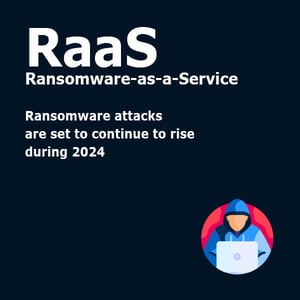 Ransomware-as-a-Service (RaaS)
Ransomware-as-a-Service (RaaS)
Ransomware attacks have become increasingly prevalent in recent years, posing a significant threat to businesses around the world. This concerning trend is projected to continue well into 2024.
What sets these attacks apart is the emergence of Ransomware-as-a-Service (RaaS), a sinister business model that allows cybercriminals to rent ransomware tools and infrastructure from developers in exchange for a share of their illicit earnings.
The rise of RaaS has opened the floodgates, enabling more hackers to enter the market and launch more sophisticated attacks than ever before. This alarming development should serve as a wake-up call for businesses to bolster their cybersecurity measures and fortify their IT systems and data against potential breaches.
Artificial Intelligence-Powered Cyber Attacks
As artificial intelligence AI technology continues to advance, its potential for use by cybercriminals also increases. AI-powered attacks have the ability to adapt and evolve quickly based on the target's behaviour, making them difficult to detect and defend against.
AI and Automation present a new and dangerous frontier for cybercrime, as hackers can now carry out attacks on a larger scale and with more precision than ever before.
To combat this threat, organisations need to invest in AI-based security solutions that can detect and prevent these types of attacks. These tools use machine learning algorithms to identify patterns and anomalies in network traffic, allowing them to distinguish between normal user behaviour and malicious activity. They can also continuously learn from new data, making them more effective at identifying potential threats over time.
A report by Darktrace reveals that 88% of surveyed organisations believe AI will become the primary method for cyber attacks in the coming years. This trend is concerning as it poses a significant threat to businesses' data and sensitive information.
Cloud Jacking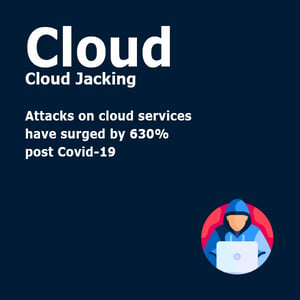
Another emerging threat in the cyber world is cloud jacking and this refers to unauthorised access and control of a company's cloud storage or server.
The growing adoption of computing in a cloud environment has made it an attractive target for malicious actors and cybercriminals. As businesses increasingly migrate their data and operations to the cloud, including Microsoft Azure, Amazon AWS and other cloud- based platforms, hackers gain easier access to valuable information stored there.
According to McAfee's 2021 Threat Prediction Report, attacks on cloud services have surged by 630% since the onset of the COVID-19 pandemic. Cybercriminals exploit vulnerabilities in cloud security protocols and employ stolen credentials to gain unauthorised access.
With the increasing use of cloud technology for data storage and collaboration, businesses are becoming more vulnerable to these attacks.
Cloud jacking can lead to a variety of consequences, from stealing sensitive information and intellectual property to disrupting business operations. It can also result in financial losses due to downtime and damage to the company's reputation.
To prevent cloud jacking, companies should prioritise strong security measures for their cloud infrastructure, which includes:
- regularly updating software and operating systems
- implementing multi-factor authentication
- conducting regular vulnerability assessments
- Training employees on best practices for securing their devices
Cloud Security
The growth of cloud technology has been remarkable. As a result, robust security measures are now more important than ever to protect valuable data. This is especially crucial for IoT devices.
By utilising cloud-based security solutions, businesses can enjoy a range of advantages. These include centralised device management and monitoring capabilities, empowering businesses to efficiently oversee their connected devices.
Moreover, the ability to swiftly deploy security updates and patches across all connected devices ensures enhanced protection against emerging threats.
Cloud-based solutions offer scalability and flexibility, making them an ideal choice for businesses of all sizes. They can cater to specific needs and growth requirements, providing the right solutions for success.
 Supply Chain Attacks
Supply Chain Attacks
Supply chain attacks are an increasingly prevalent cyber threat. These attacks occur when hackers target a company's software and hardware suppliers to gain unauthorised access to their systems.
During these attacks, hackers insert malicious code or malware into legitimate software updates or hardware components. This stealthy infiltration allows them to breach a company's network without detection.
The highly publicised Royal Mail attack in 2023 highlights the importance of addressing cyber threats within an organisation. As a result, the Royal Mail invested over £10m in ransomware remediation, demonstrating the significance of proactive measures to mitigate such risks.
This incident underscores the critical importance of robust third-party risk management and thorough vetting of all suppliers.
To ensure your business or organisation is kept secure, it is crucial to be aware of these supply chain attacks and implement rigorous measures to mitigate the associated risks.
Deep Fakes and Disinformation
The proliferation of deepfakes and disinformation has emerged as a significant concern in the cyber landscape. Deep fakes refer to manipulated videos or images that convincingly mimic reality, posing a threat to the spread of false information and manipulation of public opinion.
The use of deep fakes for political purposes has already been witnessed in numerous countries, underscoring the importance for businesses to implement robust security measures to safeguard against such attacks.
Moreover, given the growing reliance on social media platforms for communication and marketing, it is crucial for organisations to educate their employees on effectively identifying fake news and potential online threats.
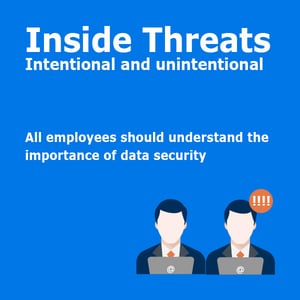 Inside Threats
Inside Threats
When it comes to network and cloud security, businesses need to consider the threat that may come from within their own organisation. Insider threats refer to malicious activities or data breaches caused by employees, contractors, or business partners who have access to sensitive information.
These threats can take different forms, including intentional data theft, unintentional data exposure due to negligence or lack of training, and misuse of privileges. Detecting and preventing insider threats can be challenging since they involve individuals with legitimate access to company systems and data.
To mitigate this risk, companies should implement strict access controls, continuously monitor user activity, and limit employee access to necessary information.
All employees should understand the importance of data security and their role in protecting sensitive information. Providing regular security awareness training is also an effective preventive measure. In the event of a suspected insider threat, companies should have an incident response plan in place to quickly respond and contain the situation.
This includes revoking access privileges, conducting investigations, and taking appropriate disciplinary actions if necessary.
Additionally, having proper data backup and disaster recovery plans will minimise the impact of insider threats and other cyber attacks, ensuring business continuity even in the face of security breaches.
5G and IoT Security Challenges
The advancement of technology has ushered in numerous benefits for businesses, such as expedited communication and enhanced efficiency. However, these advancements also bring forth new security challenges, particularly in the era of 5G and IoT (Internet of Things).
With 5G networks, boasting higher bandwidth and faster speeds, the potential for cyber attacks also increases. Moreover, the proliferation of connected devices through IoT expands the attack surface, providing hackers with more opportunities to exploit vulnerabilities.
This poses a significant threat to businesses that heavily rely on these technologies for seamless operations.
A major challenge accompanying 5G and IoT is the lack of standardisation. Different providers employing various protocols and standards make it challenging to ensure a consistent level of security across all devices and networks. Consequently, this leaves room for potential vulnerabilities.
It is crucial for businesses to address these security concerns proactively and implement robust measures to safeguard their operations and data in this rapidly evolving technological landscape.
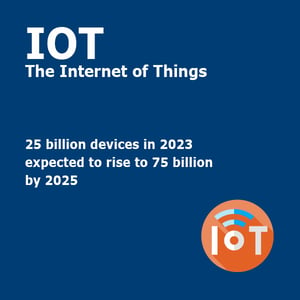 The Internet of Things (IoT)
The Internet of Things (IoT)
The Internet of Things (IoT) refers to a network of interconnected devices, ranging from smart homes and wearables to industrial equipment in factories and supply chains. These devices utilise sensors, software, and connectivity to exchange data and communicate with each other.
The rise of IoT technology brings numerous benefits for businesses, such as increased efficiency, improved customer experience, and cost savings. However, it also introduces new security challenges due to the sheer number of connected devices.
As the IoT ecosystem expands with more devices, the potential attack surface grows significantly. Hackers can target any vulnerable device within this network to gain access to sensitive information or disrupt operations.
Many IoT devices have limited processing power and memory capacity, posing challenges for implementing robust security measures. According to the latest cybercrime statistics, updated in January 2024, IoT devices are increasingly becoming targets for cyber attacks. In 2023, there were over 25 billion connected devices worldwide, and this number is expected to reach 75 billion by 2025.
Given the growing number of IoT devices, it is crucial for businesses to prioritise security measures to safeguard their data and operations. This includes implementing strong encryption protocols, regularly updating software and firmware, and ensuring proper authentication methods are in place.
Cyber Threat Intelligence
A robust security strategy for IoT devices includes the crucial element of leveraging cyber threat intelligence. This entails gathering and analysing data from various sources to identify potential threats and vulnerabilities. By staying ahead of emerging threats, businesses can proactively implement measures to safeguard their devices and networks.
Moreover, cyber threat intelligence enables early detection of attacks, facilitating a prompt response to mitigate any potential damage. It also empowers businesses to comprehend the motivations behind attacks, thereby enhancing preparedness for future incidents.
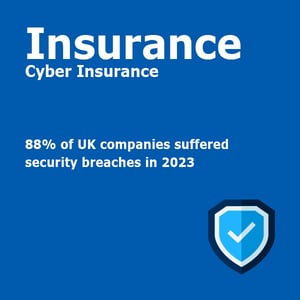 Cyber Insurance
Cyber Insurance
Businesses should seriously consider obtaining cyber insurance in addition to implementing cloud-based security solutions. This type of insurance provides protection against internet-based risks such as data breaches and cyber attacks.
Given the ongoing digital transformation and the ever-increasing amount of online data, having cyber -insurance is crucial for comprehensive risk management. It not only offers financial protection, but also provides resources for recovery, peace of mind for customers, and tailored coverage.
No company is immune to cyber threats, which is why investing in cyber -insurance is a proactive approach to safeguarding your business. Cyber insurance policies cover losses resulting from cyber attacks, data breaches, and online threats, including costs associated with business interruption and legal fees.
Some policies even offer reputation management services and resources for risk assessment and prevention, further enhancing your level of protection and preparedness.
Multi-Factor Authentication (MFA)
Implementing multi-factor authentication (MFA) is a crucial step in enhancing your company's security measures. MFA requires users to provide two or more forms of identification before gaining access to sensitive information or systems.
This additional layer of security significantly decreases the risk of unauthorised access and safeguards against common hacking methods like password theft and phishing attacks. By requiring a combination of something you know (like a password), something you have (like a code generated by an app), and/or something you are (like a fingerprint), MFA makes it considerably more challenging for hackers to compromise your company's data.
By implementing effective MFA, you have the opportunity to significantly enhance the security measures of your company. MFA brings about a greater level of security ensuring that your organisation's security is robust and reliable.
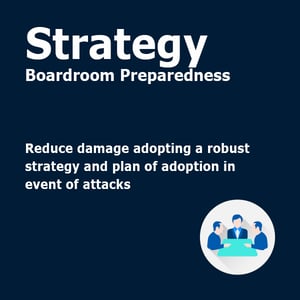 The Optimal Strategy? Boardroom Preparedness
The Optimal Strategy? Boardroom Preparedness
Businesses increasingly rely on digital platforms, which means cyber security has emerged as a critical priority for companies of all sizes. In 2024, the threat landscape will continue to evolve, necessitating a robust cyber security strategy.
The most highly effective approach for 2024 is to elevate cyber security discussions to the boardroom level. This ensures that a rigorous and comprehensive strategy for managing the risk of cyber security breaches is actively considered and that the company remains prepared on a daily, weekly, and ongoing basis.
Often most damage is caused by delays in decision making following a cyber attack through a lack of preparedness. It is possible to mitigate these delays by having a robust strategy and plan of adoption in place in the event of a cyber attack rather than waiting until it has happened.
Let us Help You
If you are unsure where to start with your company's cyber security strategy, don't worry, you're not alone. Developing a comprehensive and effective cyber security strategy can be a daunting task, especially with the constantly evolving threat landscape. We have a team of dedicated security professionals who can help you. Get in touch today.

